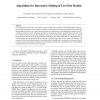Free Online Productivity Tools
i2Speak
i2Symbol
i2OCR
iTex2Img
iWeb2Print
iWeb2Shot
i2Type
iPdf2Split
iPdf2Merge
i2Bopomofo
i2Arabic
i2Style
i2Image
i2PDF
iLatex2Rtf
Sci2ools
114
Voted
CGF
2005
2005
Algorithms for Interactive Editing of Level Set Models
Level set models combine a low-level volumetric representation, the mathematics of deformable implicit surfaces, and powerful, robust numerical techniques to produce a novel approach to shape design. While these models offer many benefits, their large-scale representation and numerical requirements create significant challenges when developing an interactive system. This paper describes the collection of techniques and algorithms (some new, some pre-existing) needed to overcome these challenges and to create an interactive editing system for this new type of geometric model. We summarize the algorithms for producing level set input models and, more importantly, for localizing/minimizing computation during the editing process. These algorithms include distance calculations, scan conversion, closest point determination, fast marching methods, bounding box creation, fast and incremental mesh extraction, numerical integration, and narrow band techniques. Together these algorithms provide ...
Related Content
| Added | 15 Dec 2010 |
| Updated | 15 Dec 2010 |
| Type | Journal |
| Year | 2005 |
| Where | CGF |
| Authors | Ken Museth, David E. Breen, Ross T. Whitaker, Sean Mauch, David Johnson |
Comments (0)

